-853X543.jpg)
KALEIDOSCOPE: ANURAG ANAND - THE STORYTELLER ARTIST
by Shantanu Ray Chaudhuri April 23 2024, 12:00 am Estimated Reading Time: 9 mins, 59 secs‘I am a storyteller with art and writing as my mediums,’ says Anurag Anand, the artist who wears many hats, when Shantanu Ray Chaudhuri and Neha Tiwari ask him how he would describe himself.
Anurag Anand wears many hats. He is a corporate professional, which anyone will tell you calls for a 24x7x365 commitment. But he is much at home with PowerPoint presentations as with the pen and canvas and brush. That despite his professional involvements, he finds time to write fourteen books and counting across genres as varied as self-help, business, historical novels, and is a painter of no mean repute tells us something about a creative soul who manages to find more than 24 hours in a day.
Anurag’s work is deeply thought-provoking. In his recent exhibition, ‘Roots’, one sees a remarkable coming together of the animated human condition with the inanimate structures that surround us. Amidst the urban chaos, his paintings speak about life. For example, H for Habitation, is an astounding series of nine paintings that capture the complexity of human emotions without any facial features, solely through depictions of man-made structures. Anurag’s experimentation with mixed media emphasises the importance of following no boundaries while expressing.
In the wake of the exhibition, held at the India Habitat Centre, the writer and artist spoke to The Daily Eye…
What does painting mean to you?
To me, visual art is the purest form of expression. Unlike language, which is bound by the dictates of grammar and vocabulary, art is unrestrained and free flowing. This uniqueness makes it a medium of limitless possibilities. Each artwork can tell a different story and every artist can speak to viewers in a language of their own, making it a source of cathartic release like none other.
Do you remember the moment that you realized you wanted to make this a medium of expression? Which artwork marked the moment you realized painting was your forte?
It will be difficult to pinpoint a particular moment. I remember the last few pages of my school notebooks being replete with doodles as far back as memory takes me. I was doing portraits of family members and painting fantastical images at a very young age, which was perhaps where my association with art truly began.
With time I found myself getting more and more comfortable with the medium and being able to express any emotion or feeling on a canvas with relative ease. The work that gave me the courage to exhibit my art and open it to public critique was titled, ‘Muse Amused’. It was a painting of one of the most painted animal muses, horses, which captured their reaction to being portrayed in diverse styles by celebrated artists. The fact that I was able to capture such a complex thought on a canvas told me that I was ready for more.
What inspires you to paint? Where do you get ideas from?
Painting is such an absorbing engagement that one doesn’t need any external inspiration to plunge into it. In fact, I start getting restless if I am unable to paint for a few days. It is the ‘what’ to paint that takes a fair amount of thought and planning.
I have been a keen observer of people and their emotional tribulations and exaltations. This is a trait that most writers would claim to possess, given the need to carve out interesting characters for their stories. It is among these observations that I find the ideas for my art.
Being a full-time corporate professional how do you manage time to paint?
The ‘how’ is simple. Cliched as it may sound, but if one is truly passionate about something, one doesn’t have to consciously find time for it. It is no different from those corporate professionals who are fitness enthusiasts and are able to find two hours each day to spend in the gym. In my case, the gym is my art.
The important question is ‘Why’. Why do I feel this strong urge to paint and express myself? And the answer lies in the cathartic release that art offers. The joy and relaxation that I experience while painting is almost addictive, and that is perhaps why it has become such an integral part of my existence.
Tell us more about the theme of your exhibition ROOTS…with specific references to a few of the paintings on display: The H of Habitation, Abracadabra, From a Distance, Nothing Fishy, In the Woods, Life in the City.
Roots, my recently concluded exhibition, delves into manmade structures and their intersection with nature – flora and fauna – to deliver important life lessons. When we engage with a landscape, it usually transports us to a place from our imaginings or from our memories. And this place is often associated with a set of emotions, experiences or feelings that come back to us instantly.
In my works I have used my choice of palette and the abstract interplay of nature and manmade structures to deliver my messages. The cerebral relatability of landscapes ensure that viewers engage with the works at a personal level and the intended messages are readily received.
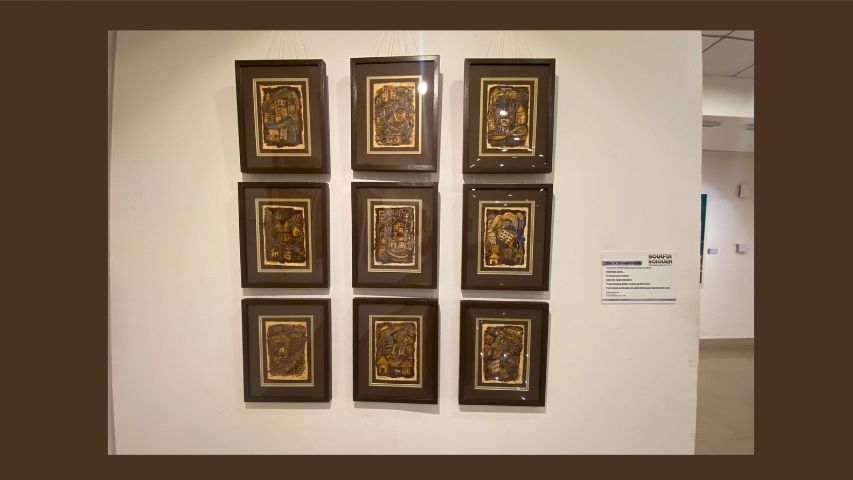
The H of Habitation: This is a series of nine landscapes painted in dark earthly tones with a touch of brighter hues. On closer look you will see the elements of the painting converge into a human face depicting a particular emotion. The emotion you discover is in turn mirrored by the original landscape that you saw. For instance, if you see the face of an old, bearded ascetic, you will see a brook and mountains to reflect the spiritual mood. This is an artistic representation of the fact that we are all shaped by the surroundings we have experienced right through our lives.
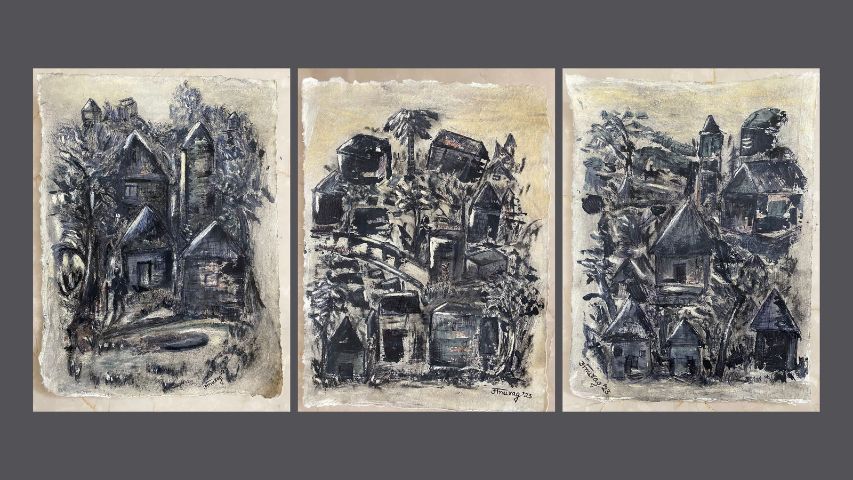
Abracadabra: This set of three works is among my favourites. While you will see simple black and white landscapes on the face of it, on closer inspection you will discover concealed shades of blue, red and green, which are a part of the paintings’ layering and lend to their appeal. The three paintings, although painted in the same palette and comprising similar elements, are likely to transport the viewers to very different and distinct geographical spaces. This, to me, is the magic of Abracadabra.
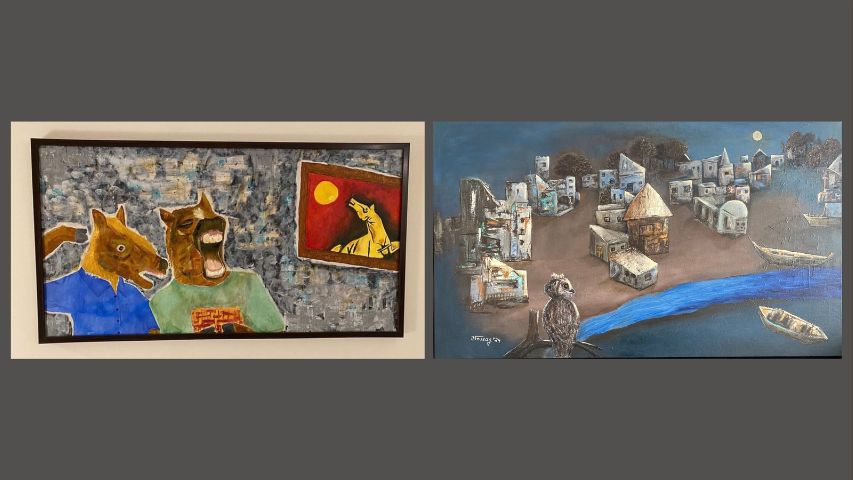
From a Distance: This is a set of two small artworks that depict a big city being observed from two different distances. In the closer one, the viewer can clearly see the skyscrapers and the many quintessential shapes and figures that make up a metropolis, whereas in the distance, all these distinct shapes dissolve into obscure abstractions. It is left for the viewer to decide as to which distance s/he finds the city more appealing from. For some, the city is at its enigmatic best up close, whereas others prefer viewing it from a distance.
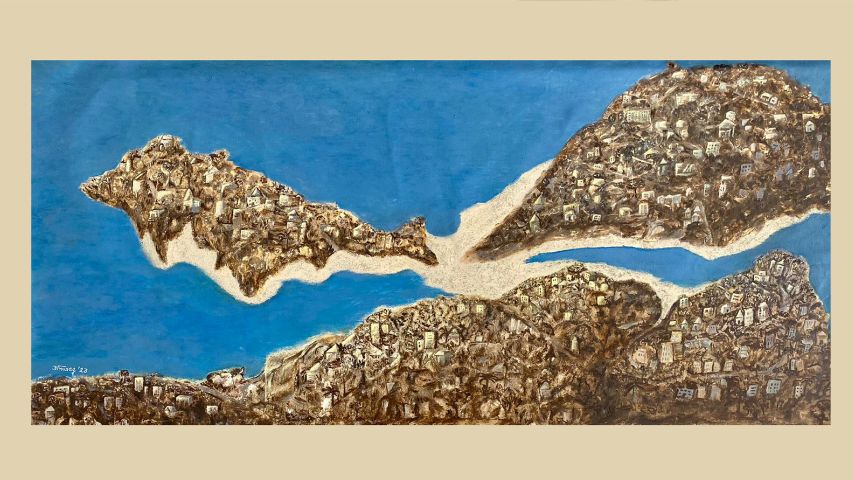
Nothing Fishy: An archipelago of densely populated islands is what one sees in this artwork. As you immerse yourself into the visual, you might see the islands acquire the form of sea creatures – fishes and turtles – posing a reminder that we humans were neither the first species on earth and nor will we be the last. It is not our collective greed, but our acceptance of the need to coexist that will shape a better tomorrow for all of us.

In the Woods: These are a set of two paintings depicting huts (cabins) in dense jungles. Different colour schemes have been used in each of the works to lend them the shades of different seasons – autumn and spring. To me, these artworks are a reflection of the peace and quiet that we so desperately seek. They are a representation of the fact that what we seek remains attainable as long as we are willing to make certain sacrifices for its sake. The choice of pulling out of the race is always ours.
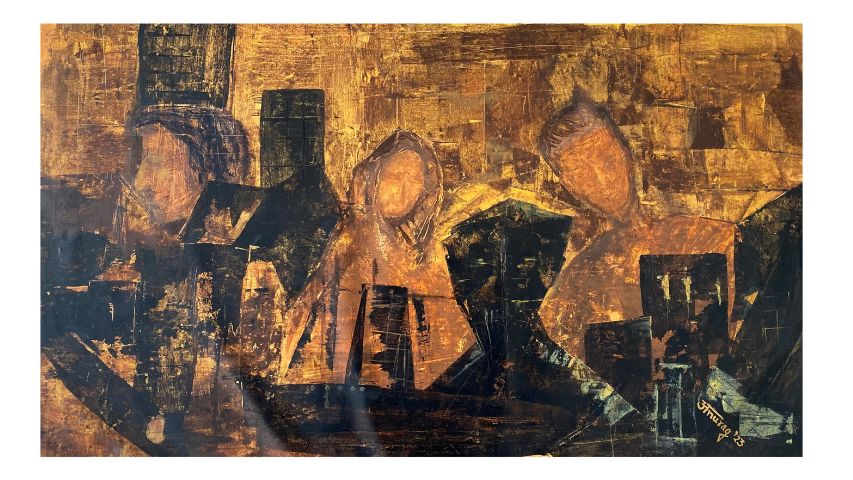
Life in the city: Depicts the chaos and frenzied pace of life in a big city… The night-time scene and the human faces are metaphors for the constant struggle that this life warrants from the dwellers. As the saying goes, ‘the city never sleeps’.
What’s your favourite medium?
I prefer working with oil paints and acrylic. The mixing of colours is way smoother with oil, but the longer drying time makes the process of creating layers in the artwork a time-consuming one. So, inadvertently I find myself working more and more with acrylic instead.
My process begins with priming the canvas – I use 2-3 additional coats of gesso on pre-treated canvas, before the first drops of paint are introduced. I also like to experiment with the surface. So, from burning the canvas sides to using different everyday items to create texture, I treat my practice as a never-ending experiment.
Can you share a brief insight of the journey from ideation to completion of the painting?
My paintings first take shape in the crevices of my mind. It starts with a thought and then I shape and reshape its visual representation, till I believe I am ready to execute it. Sometimes the execution begins with a few rough sketches to get the composition right, but I skip this step in smaller works with higher degrees of abstraction. In such works, a test sketch is restrictive and stands in the way of attaining the desired degree of abstraction.
However, once I start painting, the journey is a bit like riding a rollercoaster. The artwork often acquires a life of its own and starts taking a different shape than the one I had envisaged. The process of reining it in can be extremely taxing. The peaks, on the other hand, are when the artwork starts taking the desired shape, or when an unintended stroke lends it an enhanced character.
The biggest challenge for me though is knowing when to stop. A piece of art is never perfect, and the decision of when to announce ‘this is it’ is a tough one for me. Oftentimes I find myself going back to hitherto completed pieces after months to add a touch there and a shade there.
You are a writer too. With a number of books to your name. Which of the two is more satisfying for you and more challenging? Why? How does your approach change to the creative aspect of both? If asked to choose one over the other, which?
Art is definitely more satisfying than writing. The reason is that I usually write full-length novels, which can take several years from ideation to the final output. Contrastingly, the gratification is much quicker in the case of painting. You think of an idea, and you are able to view it in the form of a finished painting before it disappears into some crevice of the mind. And it is because of this very reason that writing is more challenging. It required unwavering commitment and discipline over a much longer span of time.
My creative approach for my writing and my art is similar at a macro level, it is only the specific steps that differ. I always begin with an idea or a message that I wish to convey, and then I give it shape and form, which is characters and their interplay in my stories just as I do in my art.
It will be difficult for me to choose one over the other. This is a bit like asking a parent to choose one among their offspring. Moreover, as long as I am comfortably able to dabble with both, there is no pressing reason for me to even delve on the possibility of having to choose one. I am happy being a storyteller with art and writing as my medium.




-173X130.jpg)
-173X130.jpg)

-173X130.jpg)
-173X130.jpg)
-173X130.jpg)
-173X130.jpg)
-173X130.jpg)